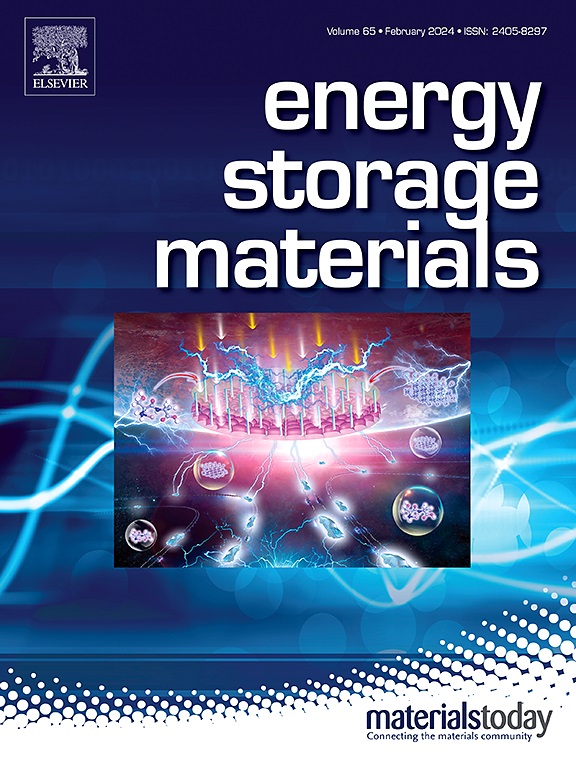Triarylamine-based polyimides enable smart electrochromic displays with energy storage
IF 20.2
1区 材料科学
Q1 CHEMISTRY, PHYSICAL
引用次数: 0
Abstract
Color-to-color switching electrochromic polymers with a high contrast ratio and the additional ability to store energy are attractive for applications in smart display devices and energy recycling and reuse. However, developing materials that combine both optimized electrochromic and energy storage performances remains a significant challenge. To address the integration of polymer color switching and energy storage, the synthesis of a donor-acceptor-donor (D-A-D) triarylamine (TAA)-based diamine monomer with the benzothiadiazole unit as the acceptor unit and using heteroatom as ion adsorption sites is here detailed. The electroactive polyimide enabling energy storage with a visual display of the state of charge (SoC) is subsequently prepared by polycondensation of the diamine monomer with 1,2,4,5-cyclohexanetetracarboxylic acid dianhydride. The final polyimide film electrode exhibits 90% optical contrast, provides a capacitance of 304.5 F g−1 at a current density of 1 A g−1, and enables SoC monitoring through multiple color changes. Besides, we further demonstrate here that symmetric quasi-solid-state electrochromic supercapacitors constructed with a polyimide film as functional layers also exhibit excellent optical contrasts above 60% and high capacitance for energy recovery and reuse in practical applications. Additionally, the ion adsorption energy and the density of states of polyimide are calculated using density functional theory to gain insight into the energy storage mechanism. Overall, we demonstrate and rationalize here the effectiveness in color switching, energy storage, and integrated SoC displaying of triarylamine-based monomers that use electron-withdrawing conjugated heterocycles as bridges along with the corresponding polyimides.
基于三芳胺的聚酰亚胺可以实现具有能量存储的智能电致变色显示器
具有高对比度和额外能量存储能力的彩色切换电致变色聚合物在智能显示设备和能量回收和再利用方面的应用具有吸引力。然而,开发结合优化电致变色和能量存储性能的材料仍然是一个重大挑战。为了解决聚合物颜色转换和能量存储的集成问题,本文以苯并噻唑为受体单元,以杂原子为离子吸附位点,合成了基于三芳胺(TAA)的供体-受体-供体(D-A-D)二胺单体。随后,将二胺单体与1,2,4,5-环己四羧酸二酐缩聚制备了具有电活性的聚酰亚胺,该聚酰亚胺具有电能存储和电荷状态的视觉显示功能。最终的聚酰亚胺薄膜电极具有90%的光学对比度,在电流密度为1 a g−1时提供304.5 F g−1的电容,并通过多种颜色变化实现SoC监测。此外,我们进一步证明了以聚酰亚胺薄膜作为功能层构建的对称准固态电致变色超级电容器在实际应用中也具有60%以上的优异光学对比度和高电容,可以实现能量的回收和再利用。此外,利用密度泛函理论计算了离子吸附能和聚酰亚胺的态密度,以深入了解聚酰亚胺的储能机理。总的来说,我们在这里证明并合理化了三芳胺基单体在颜色切换,能量存储和集成SoC显示方面的有效性,这些单体使用吸电子共轭杂环作为桥接以及相应的聚酰亚胺。
本文章由计算机程序翻译,如有差异,请以英文原文为准。
求助全文
约1分钟内获得全文
求助全文
来源期刊

Energy Storage Materials
Materials Science-General Materials Science
CiteScore
33.00
自引率
5.90%
发文量
652
审稿时长
27 days
期刊介绍:
Energy Storage Materials is a global interdisciplinary journal dedicated to sharing scientific and technological advancements in materials and devices for advanced energy storage and related energy conversion, such as in metal-O2 batteries. The journal features comprehensive research articles, including full papers and short communications, as well as authoritative feature articles and reviews by leading experts in the field.
Energy Storage Materials covers a wide range of topics, including the synthesis, fabrication, structure, properties, performance, and technological applications of energy storage materials. Additionally, the journal explores strategies, policies, and developments in the field of energy storage materials and devices for sustainable energy.
Published papers are selected based on their scientific and technological significance, their ability to provide valuable new knowledge, and their relevance to the international research community.
 求助内容:
求助内容: 应助结果提醒方式:
应助结果提醒方式:


